The Project Schedule Register
The Project Schedule register allows you to administer the implementation of Projects in stages. Using this register, you can divide each Project into stages (known as "Phases") and assign a timetable to each Phase. Each Project Transaction will then be assigned automatically to the relevant Phase (depending on the date of the originating record) and you will be able to invoice each Phase separately. You can also assign Quotation and Project Budget rows to individual Phases, so you will be able to assign Items and costs to different Phases as soon as the Project has been originated.
To use the Project Schedule register, follow these steps:
- The first step is to enter a list of the Phases that you will use in your Projects. To do this, use the Project Phases setting in the Job Costing module. This setting is essentially a look-up table for use elsewhere in the system. Specify a Code and a Comment for each Phase:
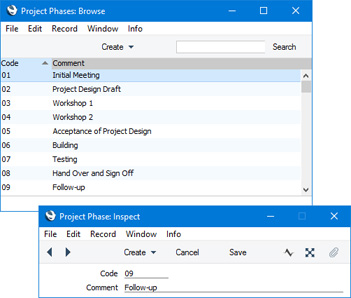
- Add the Project, Project Budget and/or Quotation in the usual way. If you already know which Phases you will use in the Project, you can assign Phases to the rows in the Project Budget and Quotation. This allows you to assign Items and services to Phases when budgeting or quoting:
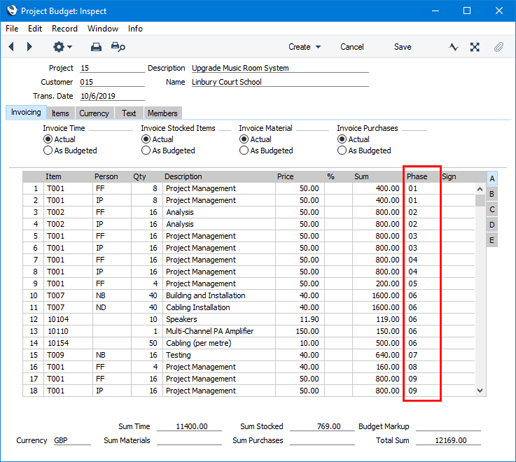
- After adding the Project, you can create a Schedule for it. You can do this before or after creating the Project Budget and/or Quotation.
You can create the Project Schedule using one of two methods:
- Open the Project in a record window and choose 'Schedule' from the Create menu.
- Enter the Project Schedule directly to the Project Schedule register in the Job Costing module.
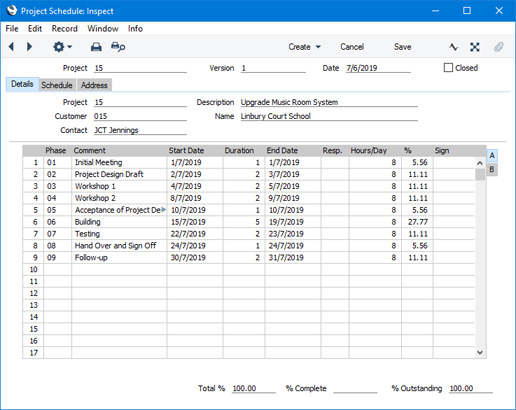
The Project Schedule register contains the following fields:
Header- Project
- Paste Special
Project register, Job Costing module
The number of the Project for which you are entering a Schedule.
- After you have entered a Project Number, the Description, Customer Number and Name and Contact Person will be brought in to the fields on the 'Details' card, and the Address and Members will be brought in to the fields on the 'Address' card.
- Version
- Usually a Project can only have one Schedule. If you need to change a Schedule while keeping a record of the original, open the Schedule in a record window and select 'Duplicate' from the Create menu (Windows/macOS) or + menu (iOS/Android). A new Schedule record will be created, a duplicate of the original but with the Version incremented by one. When you save the new Schedule, the old one will be marked as Closed automatically, rendering it inactive. This allows you to build up and maintain a schedule history.
- Date
- Paste Special
Choose date
- The date when the Project Schedule was entered. The default is the current date.
- Closed
- You can mark a Project Schedule as Closed if you don't want it to be used.
- If you create a new version of a Project Schedule, the old one will be marked as Closed automatically when you save the new one.
- After marking a Project Schedule as Closed and saving, it will not be possible to re-open the Schedule. You will need to duplicate the Schedule and create a new Version.
Details CardThe fields on the 'Details' card will be filled in when you specify a Project in the header.
Schedule CardUse the grid on the 'Schedule' card to list the Phases in the Project.
Flip A- Phase
- Paste Special
Project Phases setting, Job Costing module
- Choose a Project Phase using 'Paste Special'.
- Comment
- The Comment will be brought in from the Project Phases setting, but you can change it if necessary.
- Start Date, End Date
- Paste Special
Choose date
- The dates when work on the Phase is due to start and end.
- Each Project Transaction will be assigned to a Phase depending on the date of the transaction from which the Project Transaction was created.
- Duration
- The number of days to be spent working on the Phase.
- The Duration may not necessarily be the difference between the Start and End Dates because that period might include weekends and holidays or the work might be intermittent.
- This field is for information only. If you need the Duration to be printed on Project Schedule documentation, add the "Days of Duration" field to the Form Template.
- Resp.
- Paste Special
Person register, System module and Global User register, Technics module
- The Person responsible for the Phase.
- This field is for information only. If you need the Responsible Person to be printed on Project Schedule documentation, add the "Responsible Person" field to the Form Template.
- Hours/Day
- The number of hours in the working day.
- This field is for information only. If you need the Hours per Day to be printed on Project Schedule documentation, add the "Hours per Day" field to the Form Template.
- %
- Use this field to register the proportion of the full Project that is represented by the Phase. This will be used to calculate the Total %, % Complete and % Outstanding figures in the footer.
- Sign
- Paste Special
Person register, System module and Global User register, Technics module
- Entering a Signature in this field signifies that the Phase has been completed.
- After adding a Sign. to a Phase, you will no longer be able to create Project Transactions for that Phase. For example, if a Phase with a Sign with a runs from June 1 to June 7 and you try to save an Activity dated June 6, you will be told "Project Phase is Finished". This will help prevent creating Project Transactions for Phases that you have already invoiced using the 'Invoice for Completed Phases' function.
- If the Sign field for a Phase is empty, the % of the Phase will be included in the % Outstanding figure in the footer. If the Sign field is not empty, the Phase will be included in the % Complete figure in the footer.
- If a Project has Phases and you will need to create Invoices when Phases are completed, you can create those Invoices from the Project Budget using the 'Invoice for Completed Phases' function on the Create menu. If the Project will be invoiced on an "Actual" basis, entering a Signature in this field will be enough for the 'Invoice for Completed Phases' function to determine that the Phase has been completed. But if the Project will be invoiced on an "As Budgeted" basis, you should also enter a Signature in the Sign field in the relevant Project Budget row(s).
Flip B- Deadline
- Paste Special
Choose date
- The date when work on the Phase should be completed.
- This field is for information only. If you need the Deadline to be printed on Project Schedule documentation, add the "Due Date" field to the Form Template.
FooterThe fields in the footer contain calculated values as follows:
- Total %
- The total sum of the percentages entered in the rows.
- % Complete
- The total sum of the percentages entered in rows that have been completed (rows in which the Sign field is not blank).
- % Outstanding
- The total sum of the percentages entered in rows that have not been completed (rows in which the Sign field is blank).
Address CardThe fields on the 'Address' card will be filled in when you specify a Project in the header. If you change the Members in the Project, that change will be copied to the Project Schedule automatically.
- Save the Project Schedule in the usual way. After saving, the Project Schedule can be changed and updated at any time, but you can specify that Schedules can only be changed by Project Managers. To do this, follow these steps:
- Assign every member of staff to an Access Group in which you have granted Full access to the 'Disallow Changing Project Schedule if not Project Manager' Action. You may wish to grant Full access to the 'Disallow Changing Project if not Project Manager' Action as well.
- When entering a new Project, list the Project Managers on the 'Members' card in the Project window. You can assign up to five Project Managers to a Project. If you are using the 'Disallow Changing Project if not Project Manager' Action, be sure to assign at least one Project Manager to a Project before saving for the first time, otherwise it will not be possible to update the Project later.
After following these steps, only Project Managers will be able to edit Projects and Project Schedules. Protecting the Project means that unauthorised users will not be able to appoint themselves as Project Managers, but you may want to achieve this in other ways (e.g. by giving Read access to the Project register or by denying access to that register altogether).
If you need senior managers to be able to edit any Project or Project Schedule, do not assign them to Access Groups in which you have granted full access to the 'Disallow Changing Project if not Project Manager' and 'Disallow Changing Project Schedule if not Project Manager' Actions.
- If necessary, you can create a Mail from the Project Schedule at any time. To do this, open the Project Schedule in a record window and select 'Email' from the Create menu. The current user will be the sender of the Mail, and the recipient will be the Contact in the Project Schedule. If there is no Contact or the Contact does not have an email address, the recipient will be the Customer. A PDF version of the Schedule will be attached to the Mail, accessible through the Document Manager. This requires you to have designed a Form Template to be used when printing Project Schedules, and to have assigned that Form Template to the Project Schedule Form using the 'Define Form' function. The Project Schedule record and the Mail will be connected through the Link Manager.
- Record the work carried out on the Project in the usual way, using Time Sheets, Time Activities, Expenses, Purchase Invoices, Deliveries, Stock Depreciation records and Returned Goods. The Project Transactions that will be created from these records will include a Phase that will be assigned automatically depending on the date of the originating record. For example, if a Project Schedule includes three Phases running from June 1 - 10, June 11 - 20 and June 21 -30 and a Project Transaction is created from an Activity dated June 15 , that Project Transaction will be assigned to the second Phase.
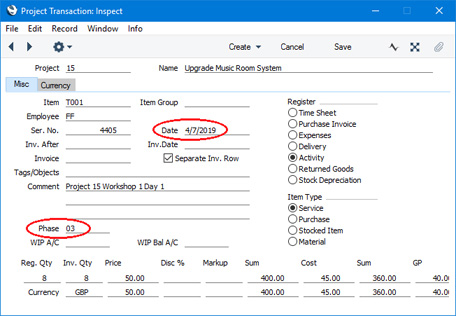
If a Phase has been completed (see step 7 below), it will not be possible to save the originating record or create the Project Transaction. A message "Project Phase is Finished" will appear when you try to save the originating record. Note: from a Time Sheet, the "Project Phase is Finished" message will depend on the date in the header of the Time Sheet, not on the dates in the rows.
- When all work on a Phase has been carried out and all Project Transactions have been created, you can mark the Phase as Completed. To do this, enter your Signature in the Sign field in the relevant row in the Project Schedule record:
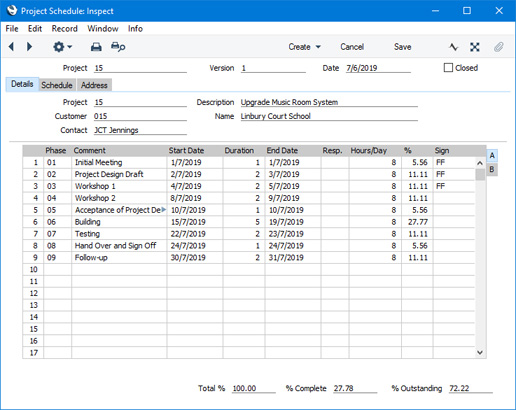
After saving the Project Schedule, it will no longer be possible to create Project Transactions with dates that fall within the Completed Phase's Start and End Dates.
If the Project will be invoiced on an "As Budgeted" basis, enter your Signature in the Sign field in the relevant Project Budget rows as well. For an "As Budgeted" Project, you should enter your Signature in the Sign fields in both the Project Schedule and the Project Budget. Doing so in the Project Schedule will prevent the further creation of Project Transactions and will also update the Project Revenue Recognition report, while doing so in the Project Budget will ensure that the 'Invoice for Completed Phases' function described in the next step will create Invoices correctly.
- If a Project has Phases, there are two options that you can use to create Invoices:
- If you use the 'Create Project Invoices' Maintenance function or the 'Invoice' function on the Create menu in the Project Budget record window, the Project Phases will not affect how the Invoices are created.
- If you use the 'Invoice for Completed Phases' function on the Create menu in the Project Budget record window, Invoices will only be created for work carried out on Phases that have been marked as Completed. If you are creating Invoices on an basis, a Completed Phase is a row in the Project Budget in which the Sign field contains a Signature.
---
Go back to:
|
